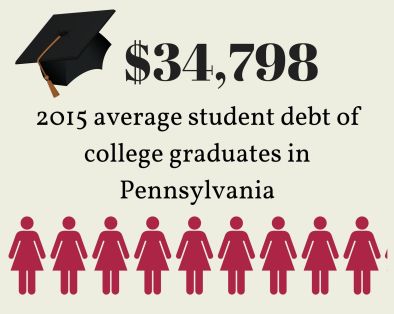
The financial burden of loans that a student will have to pay off for many years after graduation creates considerable stress throughout one’s four years of college.
According to The Institute for College Access and Success, the average debt that a college student graduated with in the state of Pennsylvania in 2015 was approximately $34,798.
This is only one of the several economic concerns that face college students in today’s society. Another important issue that is sometimes overlooked is the day-to-day financial stress that college students are coping with.
In addition to my full-course load, I am one of many students across the United States who has been faced with too many tough decisions about how to pay for the remaining tuition balance that is leftover after accounting for my Dean’s scholarship, grants and loans that are available to me based on how my financial need is recognized.
Since my tuition is not completely covered, I have found myself working 15 to 30 hours as a waitress each week in addition to trying to maintain a high enough GPA that will not jeopardize the availability of my scholarship.
Every semester I have at least once come to a point where I am stressed and tired of being broke again because I just had to pay off all the related expenses that come in addition to the cost of attending college. More specifically, the cost of commuting, paying for books and supplies and then finally, once the semester ends, I am always stuck in the same position of having to find a way to pay the remaining balance off my tuition to attend school again the next coming semester. It is exhausting.
There is a nationwide growing concern on the topic of college affordability.
According to the 2016 College Affordability Diagnosis, which is a report that was released by the University of Pennsylvania, Vanderbilt University and the Higher Education Policy Institute, a student’s family on average has to cough up 37 percent of its income for a public four-year university.
Even though low and middle income families are facing economic difficulties that decrease their ability to invest in their child’s education, the government has not done enough to lessen the financial burden on families trying to send their children to college.
From 2010 to 2014, the state of Pennsylvania cut more than $200 million from higher education. As state funding into higher education decreased, tuition prices rose, as well as the stress placed on students trying to further their education after graduating high school.
Twenty years ago, some would say a high school diploma was all that you needed in order to be successful and get a job that would support you and your family financially.
Fast forward to today, a college education is a requirement for many middle class jobs. As the percentage of the population that enrolled in a college increased in the 1980’s, state appropriations toward higher education decreased and tuition prices have increased.
How has the tuition hike since 1980 been increasing the stress levels of college students?
According to a survey of 19,000 college students conducted by researchers at Ohio State University, 60 percent of respondents were concerned about having enough money to continue paying for school.
Since 1980, the total cost of attendance at private four-year public colleges has increased 162 percent, 168 percent at four-year private non-private colleges and 69 percent at community colleges.
Financial aid did not keep up with rising inflation at this time. In 1980, the average pell grant was covering 73 percent of the cost of attending a public four year college but, today it only covers 33 percent.
A 2015 survey of college students also found that 34 percent of first-year students and 38 percent of seniors reported that economic concerns affected their academic performance.
Addressing the crisis has become a political issue. President Obama has proposed making community college free to nearly all Americans and Donald Trump has expressed his plan to increase pressure on academic institutions with large endowments to spend more on students.
These are just suggestions and there has not been enough action made to decrease the financial stress that affects a college student’s academic performance.
What needs to be done?
If Donald Trump decides to go ahead with his plan on increasing pressure on the academic institutions, tough criteria needs to be established in terms of how colleges are spending more through government assistance. More specifically, the tough criteria needs to ensure that the academic institution is not spending the aid that could be provided to students on expenses that are unrelated to the academic mission of the institution.
The government has to do more for students who worry about their financial obligations to pay for college more than their academic performance.




Dear Jaclyn,
I read your editorial with great interest, as the issues you address are, indeed, quite stressful! You did excellent research, and you are to be applauded. Thank you.
For several years I taught English composition courses at Cabrini. I not only taught, but I learned quite a bit from my students as well. I look back fondly on those days and on those students/teachers.
Might I now, as then, make just a few suggestions regarding some grammatical points for your consideration?
I happen to think that the expression “graduating high school” is more an oral expression rather than a written expression. I would prefer to read “graduating from high school,” adding the preposition “from.” In other words, the high school didn’t do the graduating, itself!
Also, the word “criteria” is the plural form of “criterion,” and, therefore, requires a plural form of the verb. It should be, for instance, “the criteria need” rather than “criteria needs.”
You write so very well, in my opinion; my suggestions might just make it even better! What do you think?